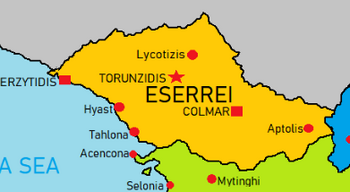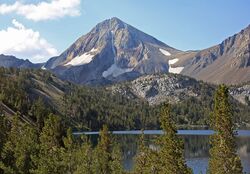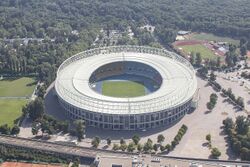Eserrei
The Allied States of Eserrei Eser sąjungininkės | |
|---|---|
 | |
| Capital and largest city | Torunzidis |
| Official languages | Eser |
| Ethnic groups | 78% Eser 12% Other Nortuan 10% Other International |
| Demonym(s) | Eser |
| Government | Representative Democracy |
| Legislature | National Assembly |
| Eserrei Senate | |
| Assembly of Delegates | |
| Population | |
• 2020 estimate | 18,239,200 |
• Density | 30.9/km2 (80.0/sq mi) |
| HDI (2019) | 0.802 very high |
| Currency | Eser mark |
| Date format | yyyy.mm.dd |
| Driving side | right |
| Calling code | +187 |
| Internet TLD | .ei |
The Allied States of Eserrei, or Eserrei, is a nation in the Coalition of Crown Albatross located in the far northwest corner of the continent of Nortua on the Casarta Sea. Eserrei is bordered by the Casarta Sea on the west, Latilli to the south and North Icadania to the east. It covers an area of 589,306 square kilometers (227,532 sq. miles) with a population of 18,639,300. The capital and largest city of Eserrei is Torunzidis, with a population of 1,233,120 people. It sits of the east bank of the Fortis River in the central state of Kalo. Being a relatively young nation and it's remote location in northwest Nortua, Eserrei is a newcomer to the world stage after years of neutrality.
Origin
Early Period
Nobility Period
Unification of Eser speaking independent states
Modern day Eserrei began in its current form in 1694 following the union of the 7 independent Eser-speaking city-states of Kalo, Proleis, Burzinai, Etlan, Jovanai, Modil, and Sortinas These city-states often in competition with each other, found external threats to be the larger concern for stability and survival. Additionally political leaders in Kalo and Burzinai had begun having talks of what a single nation of Eser people would look like.
Unification started with the joining of Kalo and Proleis as one state in 1683. Proleis and Kalo were already allies with Proleis needing access to the sea and depending on Kalo"s strength militarilly. This was followed by incorporating Jovanai in 1685. The three states in union now went under the name Eserrei for the first time. with central government in Torunzidis. Burzinai and Etlan joined the union a few years after in 1690 leaving only the southern most states of Modil and Sortinas still independent. The eventually applied for union in 1698 and 1699 respectively.
Geography and Climate
Geography
The physical landscape of Eserrei is quite varied when traveling west to east. There can be considered 4 main natural regions. Along the northwestern coastline is a moderately undulating coastal plain which is suitable for famring and development. The city of Erzytydys sits on the Etlan Bay which is a major seaport of Eserrei. North of the developed area the northwest region is densely forested of Douglas fir, ponderosa, redwood, and the giant sequioa trees.
The interior portion of Esserei before the mountains is a grassy plateau of river valleys that are very suitable for both agriculture and development. The 3 major rivers of this region, the Anatara, Fortis, and Laisten played a major role in shaping the geographic and econmoic fortunes of the Kalo and Burzinai states. The ease of travel through these river valleys allowed for the population to grow the quickest of all of Eserrei's states. The rivers often flood in the spring due to snow melt and a raininy spring season which is common. Fishing esepecially of Salmon is very common and plentiful near the coast of the Casarta Sea. To the north is where the upper Kyddis mountains dominate the landscape. The land here is far more rugged with deeper valleys and mostly rocky mountains making travel and development more difficult.
The largest of which is Mt. Pilotin which rises to 9,415ft above sea level and is located in the state of Jovanai.
Climate
According to the Köppen climate classification, most of the coastal Western Eserrei has a warm-summer maritime climate, which features warm, dry summers, and wet winters with frequent overcast and cloudy skies. Mountainous Eastern Eserrei falls into the cold semi-arid climate, which features much drier weather with much more extreme temperatures in both summer and winter. The city of Aptolis for example is both the coldest and hottest for average temperatures among Eserrei's largest cities. Temperatures in the summer regularly more beyond 90 degrees F, while in the winter hover around or below the freezing mark for the majority of the season.
Administrative Divisions (States)
The seven states that make up Eserrei are in alphabetical order, Burzinai, Etlan, Jovanai, Kalo, Modil, Proleis, and Sortinas.
Demographics
The population of Eserrei as of the 2020 national census was 18,639,300 people spread across 7 states and 23 secondary counties. By 2015 the expected population of Eserrei will be over 20 million. Recently immigration policies have changed to encourage more inbound permanent visas to compensate for a lowering birth-rate. The current birth-rate is 1.96 births per woman and has been in decline for roughly 3 decades. Most immigration comes from other Nortuan states.
Largest Cities
Largest cities in Eserrei
2020 Census | |||||||||
|---|---|---|---|---|---|---|---|---|---|
| Rank | Province | Pop. | |||||||
 Torunzidis  Hyast |
1 | Torunzidis | Kalo | 1,233,122 |  Erzytydys  Skille | ||||
| 2 | Hyast | Burzinai | 753,330 | ||||||
| 3 | Erzytydys | Etlan | 724,252 | ||||||
| 4 | Skille | Sortinas | 695,044 | ||||||
| 5 | Aptolis | Modil | 524,890 | ||||||
| 6 | Lastelai | Burzinai | 521,452 | ||||||
| 7 | Tahlona | Kalo | 310,232 | ||||||
| 8 | Colmar | Jovanai | 282,610 | ||||||
| 9 | Lycotizis | Proleis | 256,030 | ||||||
| 10 | Trome | Sortinas | 229,741 | ||||||
Religion
Culture
Sports
Many Eser enjoy spectacing and participating in sports. The most popular sports nationwide include association football, downhill and cross-country skiing, tennis, cycling, ice hockey and motor racing. Being a colder weather nation in much of the country, Eserrei performs better in these events than traditional warm weather competitions internationally. In the last few decades youth participation in tennis has grown particularly with the construction of indoor tennis facilities to allow for players to compete year round even though the temperatures in most of Eserrei in the winter can be very cold.
One of the more popular spectator sports series is the Eserrei Super Kart series. The Super Kart series is a single seat open wheeled car series with races all over the country. The series takes place from April through October and has existed in its current form since 1963.
Eserrei also has national leagues for ice hockey and association football which draw large crowds. Vintas National Stadium is the traditional home for the Eser national football team as well as hosting national competitions. The stadium is in the northeast neighborhood of Ilintai and has a capacity of 59,000. Polva stadium in Tahlona also hosts national football team games in its 52,000 seat stadium.
Eser Super Lyga
The Eser Super Lyga (ESL) is the top level of professional association football in Eserrei. The league headquarters were founded in and are located in Hyast, Burzinai. The season runs from March to October due to the cold and snowy weather in much of the country during winter months. The most successful clubs of the ESL are mainly found in the coastal regions of Burzinai and Kalo as well as the capital region. Those clubs are Olimpiada Hyast, FK Torunzidis, Olimpiada Torunzidis, FK Laistelai, Isterais Aptolis and Inkaras Tahlona. Collectively known as the Power 6 among fans and sports writers these clubs have traditionally been where the top players in Eserrei end up and have the most league championships. Of these clubs Olimpiada Hyast has the most national league titles with (11).
Government
Executive
The executive branch of the nation is the formal head of state. The office is the President of the Allied States of Eserrei. The president is an elected position using a direct vote of the population. The current president is Laima Parsukine of the Federalist party. The president is tasked with forming an executive Committee of Ministers who each handle an individual portion of the government.
Legislative
The legislative body upper house of Eserrei is the Eser Senate. Members of this body represent the state from which they are elected. Each state is allowed 10 senators to be chosen among among the population in the manner of that state's election preference. Each term for the senators is 6 years with a limit of 18 years or three terms.
The lower house is the Assembly of Delegates of Eserrei. Voted in members sit in single delegate assembly districts allocated to each state on a basis of population as measured by the Eserrei Census, with each district having one delegate representative. all delegation members are directly elected. The term length for all elected Delegates in the lower house is four years with a limit of serving 20 years. The total number of Delegates in the lower house is 155 with each member serving approximately 120,000 citizens.
| State | Population | Number of Delegates |
|---|---|---|
| Burzinai | 4,190,210 | 35 |
| Kalo | 3,783,120 | 31 |
| Sortinas | 3,445,100 | 29 |
| Modil | 2,463,780 | 20 |
| Etlan | 1,758,970 | 15 |
| Jovanai | 1,451,730 | 12 |
| Proleis | 1,246,390 | 10 |
Major Political Parties
Foreign Relations
Economy
The Central Bank of Eserrei in Torunzidis serves as the central bank for the country. The Eser currency is the Eser mark (Esm).The Eserrei economy has grown substantially in the 20th and 21st centuries due to a stable government and policies that encourage private investment including foreign investment.
The largest sectors of the Eserrei economy are the Timber, Fishing/Seafood, Natural Gas, Service, Mining and Tourism.




